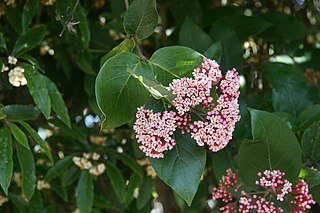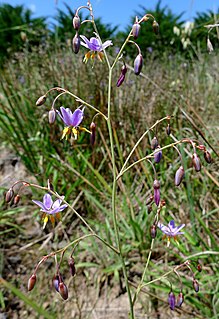Related Research Articles

The lazuli bunting is a North American songbird named for the gemstone lapis lazuli.

Clarkia is a genus within the flowering plant family Onagraceae. Over 40 species are currently classified in Clarkia; almost all are native to western North America, though one species is native to South America.

Clarkia amoena is a flowering plant native to western North America, found in coastal hills and mountains from British Columbia south to the San Francisco Bay Area.
Emily Jean Stevens (1900–1967), usually known as Jean Stevens, was a New Zealand iris hybridiser in the 1940s and 1950s who created the 'Pinnacle' iris as well as a number of other outstanding amoenas.

Magnolia amoena is a species of plant in the family Magnoliaceae. It is endemic to China. It is threatened by habitat loss.
Griphobilharzia amoena is a significant trematode that infect crocodiles such as the Australian freshwater crocodile, Crocodylus johnstoni, located in Darwin, Australia with reported illness in Irian Jaya as well. They possess a distinctive tegument that is composed of two lipid bilayers instead of a single bilayer. The double bilayer may be an adaptation to survive the host's immune response.

Changnienia is a genus of flowering plants from the orchid family, Orchidaceae. Only one species is known, Changnienia amoena, native to China.

Vexatorella is a genus containing four species of flowering plant, commonly known as vexators, in the family Proteaceae. The genus is endemic to the Cape Floristic Region of South Africa. The name means “little trouble-maker”, given with reference to the initial difficulties of placing V. latebrosa within the family. All species are shrubs which occur in dry fynbos habitats on the fringes of the Succulent Karoo ecoregion. The inflorescences are similar to those of the related leucospermums but also share features of the leucadendrons, with the floral bracts becoming woody and enlarged following pollination. The flowers are insect-pollinated, with the seeds dispersed by ants (myrmecochory).

Rogiera amoena is a shrub or small tree in the family Rubiaceae, sometimes grown as an ornamental plant. Common names include rondeletia and yellowthroat rondeletia. The species is native to Mexico, Belize, Guatemala, El Salvador, Nicaragua, Costa Rica and Panama.

Hemilophini is a tribe of longhorn beetles of the subfamily Lamiinae.

Rubramoena amoena is a species of sea slug, an aeolid nudibranch, a marine gastropod mollusc in the family Fionidae.
Eulachnesia humeralis is a species of beetle in the family Cerambycidae. It was described by Johan Christian Fabricius in 1801. It is known from Brazil.
Eulachnesia cobaltina is a species of beetle in the family Cerambycidae. It was described by Bates in 1881. It is known from Colombia.
Eulachnesia monnei is a species of beetle in the family Cerambycidae. It was described by Martins and Galileo in 1996. It is known from Brazil.
Eulachnesia smaragdina is a species of beetle in the family Cerambycidae. It was described by Bates in 1872. It is known from Panama and Nicaragua.

Vexatorella amoena, also known as the Swartruggens vexator is an evergreen shrub of up to about 1 m (3 ft) high, that is assigned to the family Proteaceae. It has entire, inverted egg-shaped, bluish grey, leathery leaves of 1½–3 cm (0.6–1.2 in) long and 5–11 mm (0.20–0.45 in) wide on a distinct stalk, and globular flower heads of about 2 cm (0.8 in) across with pale pink flowers with extended, thick-tipped styles at the tip of the branches. The plants are flowering from September to November. It is an endemic species that is restricted to the Western Cape province of South Africa.

Felicia amoena is a variably hairy, sometimes glandular, biennial or perennial plant, of about 25 cm (10 in) high, that is assigned to the daisy family. It is somewhat woody at its base, roots at the nodes if these contact the soil, and has ascending branches. The leaves are oppositely arranged along the stems at and just above a branching fork, further up the leaves alternate. The flower heads sit individually on up to 12 cm long stalks. They are 2–3 cm in diameter and consist of about twelve to twenty five heavenly blue ray florets that surround many yellow disc florets. Three subspecies have been recognised, that differ in width of the leaves and the involucral bracts, the size of the heads and number of ray florets and in having glandular hairs. These can be found in coastal sands and inland areas in the Western Cape and Eastern Cape provinces of South Africa. Flower heads can be found from June till October.

Echeveria amoena is a species of succulent plant in the family Crassulaceae, endemic to semi-arid areas of the Mexican states of Puebla, Tlaxcala, and Veracruz.
Mazuca amoena is a moth in the family Noctuidae. It can be found from the Democratic Republic of the Congo to Zimbabwe, with one instance in South Africa.

Dianella amoena, commonly known as the matted flax-lily, is an endangered, herbaceous, perennial plant endemic to Australia. It belongs to the family Asphodelaceae, subfamily Hemerocallidoideae. It has long grey-green leaves which grow in clumps from an underground rhizome, and displays blue-purple flowers in spring-summer, up to 90cm in height. The common name Matted Flax-lily refers to its extensively rhizomatous nature, sometimes forming large mats up to 5m wide.
References
- ↑ BioLib.cz - Eulachnesia amoena. Retrieved on 8 September 2014.